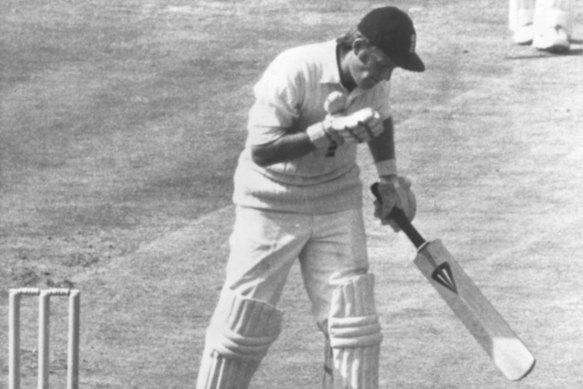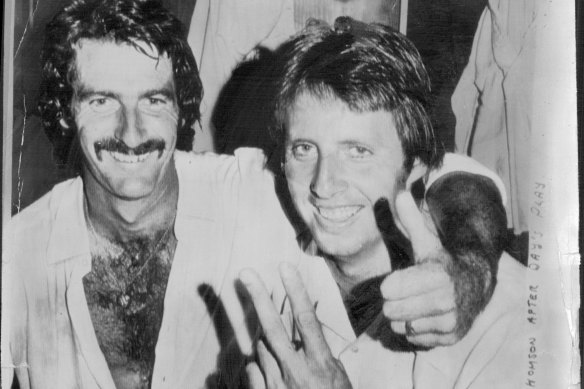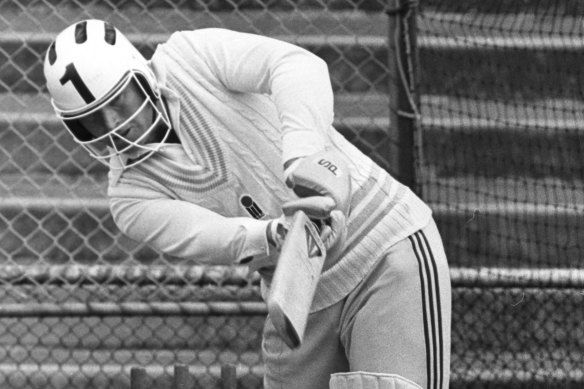This was published 3 months ago
The English batsman who enlisted a hypnotist to get over Lillee and Thomson bombardment
By Simon Briggs
Fifty years ago this winter, an unassuming fellow from Birmingham walked to the middle of Brisbane’s Woolloongabba Stadium.
Dennis Amiss did not know it yet, but he was about to become the protagonist in one of the most bloodthirsty sporting spectacles since the gladiators left the Colosseum.
The 1974-75 Ashes have long been notorious among cricket aficionados. Across the first five Tests, every one of England’s batsmen took a series of juddering blows from the extreme pace partnership of Dennis Lillee and Jeff Thomson.
Now a new book, David Tossell’s Blood on the Tracks, has underlined the tour’s status as a tipping point. While Amiss might have suffered nothing more serious than nightmares – plus a broken thumb which kept him out of the second Test – the brutality of the experience persuaded him to experiment with a helmet, a first in the sport. At around the same time, he enlisted a hypnotist in an effort to heal his mental scars.
“I did a function with Thommo recently,” Amiss, who was 31 when he flew to Australia for that ill-fated tour, explained last week.
“I said to him, ‘You know that first ball at Brisbane, that went past my nose off a length? That really scarred me, for a long time afterwards’. He said, ‘But Den, you got out the way. When I bowled those at anybody else, I hit them on the head’. I said, ‘Had that hit me on the head, I wouldn’t be here now.’”

Dennis Amiss after being hit in the face when hooking at a bouncer in 1974.Credit: AP
Amiss had arrived in Brisbane as the flower of English batsmanship, with a Test average of 52 and five hundreds already that calendar year. Thomson, by contrast, was a virtual unknown: a bleached-blond beach bum who seemed to have washed in with the tide.
Then 24, he had spent the past couple of seasons terrorising grade cricketers for the unfashionable Bankstown club, on the wrong side of Sydney Harbour Bridge. The most unfortunate victim, Greg Bush, spent a month in hospital after a direct hit on his right eye.
“We didn’t really know what we were in for,” says Amiss now. “We hadn’t seen Thomson at all, and although we’d watched Lillee bowl in the Sheffield Shield match at Adelaide, he’d been operating at almost medium pace. Then he took the new ball in Brisbane and he was pushing off the sightscreen, 40 yards back.
“Thommo was quicker, although Dennis could be quick enough. But they both made it bounce on that off stump, and they were at me straight away. I suppose they thought I was the number one batter to start with in this series. So there was no respite.”

Dennis Lillee and Jeff Thomson tormented England’s batsmen.Credit: Fairfax Media
Was Thomson the nastiest fastie of them all? Who knows. But like Frank Tyson 20 years earlier, or Shoaib Akhtar 25 years later, he was a bowler you could not really prepare for.
Part of this was due to his unorthodox action, which Thomson himself characterised with the immortal phrase: “I just shuffle up and go ‘wang’.”
Jogging in without apparent menace, he would make a sharp sideways turn, point his left toe at the batsman’s nose, and bring his right hand – previously obscured by his back leg – into view at the last nanosecond. His coil and release was compared by an envious Bob Willis, then on his second Ashes tour, to a nuclear explosion.
In years to come, the England team’s suffering would give rise to numerous after-dinner routines. The most famous involves the private parts of David “Bumble” Lloyd, which took a ferocious battering from a Thomson thunderbolt in Perth.
To quote an excerpt from Lloyd’s retelling, which he has performed so often that he could probably deliver in his sleep, “It was a pink Litesome [box] and it had holes in it … Everything that should have been inside it had found its way through these holes and was trapped now on the outside.”
Then there was the arrival of 41-year-old Colin Cowdrey as an injury replacement for that same Perth Test, carrying a pile of foam padding that his wife had sewn into his undershirt.
‘This is Headline not Bodyline’
Cowdrey treated the whole thing as a great jape, remarking to Lloyd on what fun he was having, and going up to Thomson at a drinks break to introduce himself. The reply? “That’s not going to help you, fatso. Now p--- off.”
For Cowdrey, who averaged 18, the 1974-75 Ashes felt like a quixotic flourish at the end of a great career. Amiss took England’s 4-1 defeat more personally, because he had arrived as their batting cornerstone.
Yet no sensible observer could blame him for his disappointing numbers (175 runs at 19.44). In the words of Australia’s middle-order man Ross Edwards, “This was cricket beyond your experience. I was fielding in the covers, and I was scared for them.”
Amiss recalls now: “I got out for 40 or something during the Sydney Test. I thought I’d played the innings of my life. And as I was walking off I saw Len Hutton, who was there as a selector. I said, ‘You would remember the Bodyline series, wouldn’t you?’ And he said, ‘Yes. But this is Headline, not Bodyline. They’re aiming at your heads.’”
Amiss famously became the first proponent of a batting helmet – the product of talking to a motorcycle salesman and staring down 18 pace men who “could bowl 90 miles an hour” when Kerry Packer’s World Series came calling in 1977.
While Amiss’s helmet might have insulated his skull, he still needed help with the roiling thoughts underneath. So he accepted an invitation from a sports hypnotist, who happened to have rung him up on spec in the early months of 1977.

Dennis Amiss wears a helmet batting in the nets. The English batter was the first cricketer to adopt protective headgear.Credit: Fairfax
After putting Amiss in a trance, the hypnotist supplied him with a tape of messages to listen to before batting – although Amiss always used to pretend that it was music coming through his headphones, rather than upbeat incantations.
“I’m just trying to think of his name now,” said Amiss of the hypnotist. “He was a wonderful bloke, because he did all the rowing clubs in Melbourne, and one or two of the rugby teams.” He turned to his wife Jill, who had just appeared to offer him a Scotch egg for lunch, but she could not remember the name either.
“It worked, anyway,” concluded Amiss. “For a time,” Jill responded, with feeling. Remember that this was the late 1970s. One minute, you would be defying Lillee while the crowd chanted: “Kill, kill, kill.” (Amiss’s experience during a four-hour vigil at the Centenary Test of March 1977.) The next, you could be facing West Indian paceman Wayne Daniel on an up-country ground in New South Wales. A low score was never far away.
Happily, Amiss survived the slings and arrows of Thomson, Lillee, Daniel et al, playing on into his mid-40s and ending up as one of only 25 men to score a hundred first-class hundreds.
A popular figure around the county circuit, he would also chair the Warwickshire committee during the glory years of the mid-1990s. Today, he speaks of his career with great warmth and gratitude. And yet, the ghosts of that frightening winter have never left him.
“I remember there was a Test at Edgbaston in 1995 where the pitch was spicy,” recalled Amiss. “The first ball from Curtly Ambrose whizzed over Robin Smith’s head and reached the boundary on the first bounce.
“Dennis Silk – who was chairman of the board then – turned to me and said, ‘I’ve never seen anything like that in my life’. I said, ‘You should have been in Australia in 1974-75. Balls were taking off like that once or twice an over.’”
Blood On The Tracks, by David Tossell, is published by Fairfield Books on Oct 21.